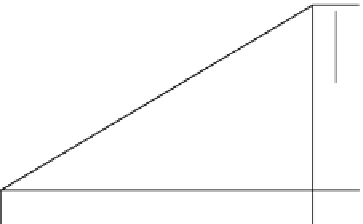Geoscience Reference
In-Depth Information
400 #
5'
J
K
W
12'
FIGURE 11.6
Illustration for Example 11.6.
rest (in equilibrium). As the angle (slope) of the ramp is increased, greater force is required
to move it, because the load is being raised as it moves along the ramp, thus doing work.
Remember that this is not the case when the cart is moved along a horizontal plane without
friction; however, in actual practice friction can never be ignored, and some work is accom-
plished in moving the cart.
Solution:
To determine the actual force involved, we can again use a resolution of forces. The first
step is to determine the angle of the ramp. This can be calculated by the formula:
Opposite side
Adjace
5
12
Tangent (angleoframp)
=
==
042
.
nt side
and arctan 0.42 = 22.8°.
Now we need to draw a force parallelogram (see Figure 11.7) and apply the trigonometric method.
The weight of the cart (
W
) (shown as force acting vertically) can be resolved into two components:
force
J
parallel to the ramp and force
K
perpendicular to the ramp. Component
K
, being perpen-
dicular to the inclined ramp, does not hinder movement up the ramp. Component
J
represents a
force that would accelerate the cart down the ramp. To pull the cart up the ramp, a force equal to or
greater than
J
is necessary.
Applying the trigonometric method, angle
WOK
is the same as the angle of the ramp.
OJ
=
WK
+
OW
= 400 lb
Opposite side (
WK
)
Sine of angle
WOK
(.
22 8°=
Adjacentside(
)
OW
)
O
22.8°
J
K
W
FIGURE 11.7
Force parallelogram.























Search WWH ::

Custom Search